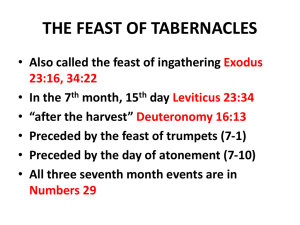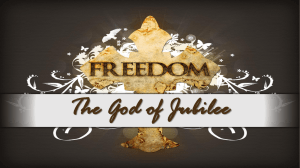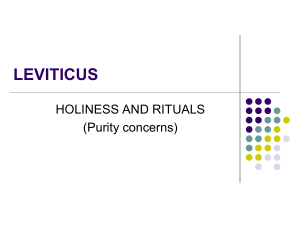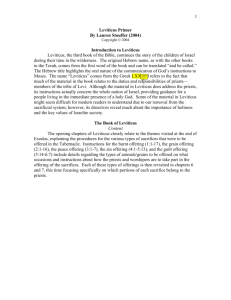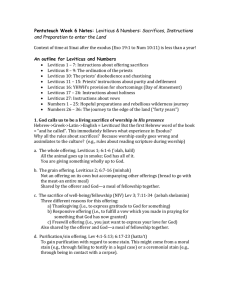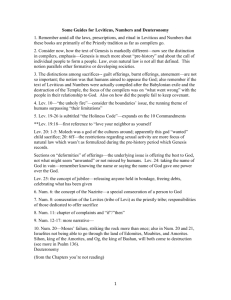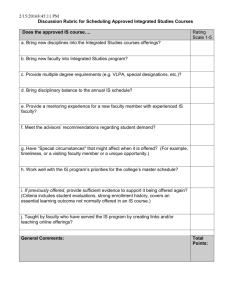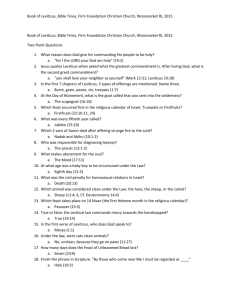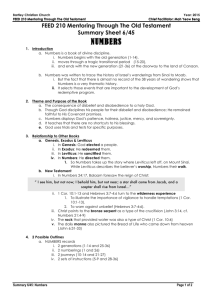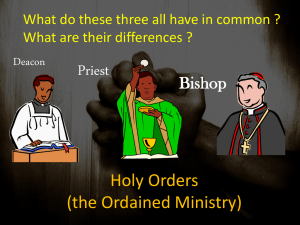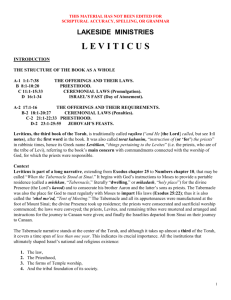LEVITICUS: Priesthood Manual of Israel
advertisement
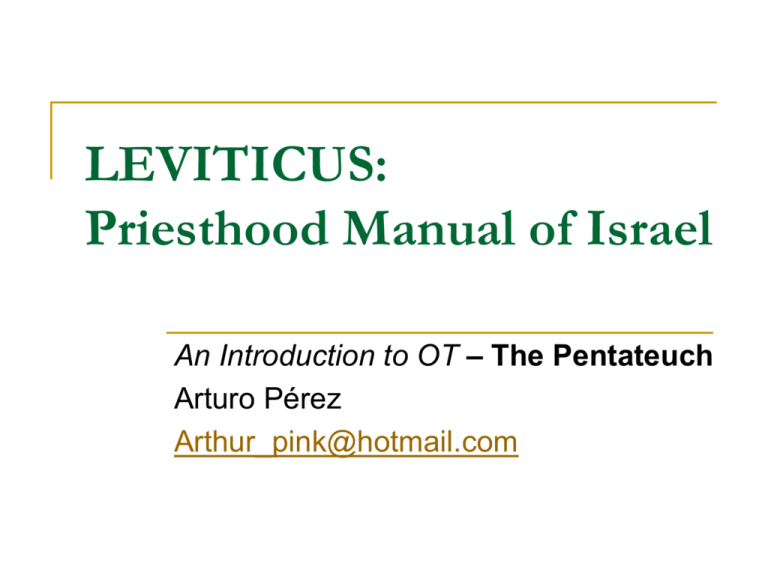
LEVITICUS: Priesthood Manual of Israel An Introduction to OT – The Pentateuch Arturo Pérez Arthur_pink@hotmail.com Contents Chronological & Geographical Context Introduction to Leviticus Name Main Subject Importance and Landmarks Outline Content of Leviticus (1 – 27) Possible Chronology of the Pentateuch 1706 1491 40 years in the wilderness Ex.16:35; Dt.1:3 Israel arrives to Egypt EXODUS 1 year: Exit & Law (215 years living in Egypt) Ex. 12:37 - 40 * Ex.12:41 1451 AC Ready to enter Canaan 40 years in the wilderness EXODUS 1-12:36 12 40 NUMBERS Marching to Canaan Leviticus Priesthood System Deuteronomy LEVITICUS IS NOT CHRONOLOGICAL Repetition of Law Canaan Moab Beersheba N Rameses Pithon Succoth Lake Bitter Lake SIRBONIS Cairo EGYPT Suez Canal KadeshBarnea Edom Makheloth Desierto de PARAN Marah Elim Peninsula Of SINAI Rephidim Mount SINAI Wilderness Of ARAB The Name “Leviticus” Hebrew Name: “And Jehovah called” YHWH wayyiqrã’ Vayikra (Hebrew: ויקרא,literally "and He called") “The Lord called” (Lev.1:1) “The Lord called”, is repeated 50 times A.K.A. “The law of the priests” (Heb. kōhēn) the word “priest” is mentioned around 730 times in the Bible Current Name: “Leviticus” The title “Leviticus” comes from LXX Λεσιτικός. It means “belonging to the Levites”. Main Subject Leviticus God’s demand for holiness and his provision for it, through the atonement of sin by appointed sacrifices and worship. Central idea in the book = HOLINESS to God. Lev.11:44 “For I am the LORD your God. Consecrate yourselves therefore, and be holy, for I am holy...” Lev.19:2 “Speak to all the congregation of the people of Israel and say to them, You shall be holy, for I the LORD your God am holy”. Key words in the book show the main subject: Offering / sacrifices (+300 times) Clean or unclean (+200 times) Holy, holiness, sanctify… (+100 times) Current Importance of this book It explains Israel religious’ background. The meaning of sacrifices and Jewish feasts bringing a specific learning or representing a prototype of the New Covenant to come. It’s indispensable for understanding the Letter to the Hebrews. Principles of abiding value. It shows the way God deals with sin. God’s attitude regarding social issues (sabbatical year; bad debts; etc.) God’s attitude regarding immorality sins Love to your neighbor. (Lv.19:18). Summary of law: Love to God and your Neighbor. MORAL Law for you social interactions with your neighbor “You shall not take vengeance or bear a grudge against the sons of your own people, but you shall love your neighbor as yourself: I am the LORD.” (Lev.19:18) CIVIL Law to protect innocent people from sinful behavior “If anyone injures his neighbor, as he has done it shall be done to him, fracture for fracture, eye for eye, tooth for tooth; whatever injury he has given a person shall be given to him. (Lev.24:19-20) Outline of Leviticus I. The appropriate way to approach a Holy God (1 – 10) A. Through sacrifices (1 – 7) B. Through priesthood consecration (8 – 9) C. Avoiding priesthood violation (10) II. The appropriate way a holy nation should live (11 – 22) A. Purification (11 – 15) B. Yearly Atonement for sin (16) C. Separation from sin (17 – 22) III. The appropriate Feasts for a holy nation (23) IV. More instructions for a holy nation (24 – 27) A. Pure oil from olives for the lamp; showbread in the Tabernacle (24) B. A sabbatical year of rest to the land (every seventh year) and the year of jubilee (every fiftieth year) (25) C. Promises and admonishments (26) D. Vows and freewill gifts (27) Outline of Leviticus I. Laws on Sacrifice (1:1–7:38) A. Instructions for the Laity (1:1–5:26 ) 1. The burnt offering (ch. 1) 2. The cereal offering (ch. 2) 3. The peace offering (ch. 3) 4. The purification offering (4:1–5:13) 5.The reparation offering (5:14–26 [ B. Instructions for the Priests (6:1 -7:38) 1. The burnt offering (6:1–6 [) 2. The cereal offering (6:7–11 ) 3. The priest’s cereal offering (6:12–16) 4. The purification offering (6:17–23) 5. The reparation offering (7:1–10) 6. The peace offering (7:11–36) 7. Summary (7:37–38) II. Institution of the Priesthood (8:1–10:20) A. Ordination of Aaron and his Sons (ch. 8) B. Aaron’s First Sacrifices (ch. 9) C. Judgment on Nadab and Abihu (ch. 10) III. Uncleanness and its Treatment (11:1–16:34) A. Unclean Animals (ch. 11) B. Uncleanness of Childbirth (ch. 12) C. Unclean Diseases (ch. 13) D. Cleansing of Diseases (ch. 14) E. Unclean Discharges (ch. 15) F. Purification of the Tabernacle from Uncleanness (ch. 16) IV. Prescriptions for Practical Holiness (17:1–27:34) A. Basic Principles about Sacrifice and Food (ch. 17) B. Basic Principles of Sexual Behavior (ch. 18) C. Principles of Neighborliness (ch. 19) D. Capital and Other Grave Crimes (ch. 20) E. Rules for Priests (ch. 21) F. Rules about Eating Sacrifices (ch. 22) G. Religious Festivals (ch. 23) H. Rules for the Tabernacle (24:1–9) I. A Case of Blasphemy (24:10–23) J. Sabbatical and Jubilee Years (ch. 25) K. Exhortation to Obey the Law: Blessing and Curse (ch. 26) L. Redemption of Votive Gifts (ch. 27) Wenham, G. J. (1979). The Book of Leviticus. The New International Commentary on the Old Testament (49). Grand Rapids, MI: Wm. B. Eerdmans Publishing Co. Summary of the book of Leviticus I. Offerings or Sacrifices. II. The Priesthood. III. Solemn feasts or holy convocation I. Offerings or Sacrifices: Purpose Purpose: To show the right way to approach God. Ex. 34:20 and Deut.16:16 mention that none shall appear before the Lord empty-handed. I. Offerings or Sacrifices: Meaning Atonement: To “cover” sins (Lv.17:11). Substitution: Putting your hands over the animal. Consecration: Separated to God’s service. Stewardship of your goods: Giving the first-fruits and from the best of their cattle. Joyful Communion: Burnt offering and also sharing and having fellowship. Worship. The sacrifice according to God’s instructions was a “pleasing aroma to the Lord” in sincere and obedient worship to Him. I. Offerings or Sacrifices: Types With Blood: shedding blood and putting your hands over the animal. The offerer killed the animal. Meaning: Shedding blood = victim’s death Sinner is identified with the victim Penalty for sin is death, but the animal dies instead of the sinner. Without Blood: Those are offerings of food from the fruits of the land representing your vows to the Lord from the works of your hands. These offerings should exclude any leaven or honey. Chapter 1 Burnt Offerings Chapter 2 Cereal Offerings Chapter 3 Peace Offerings Cattle (v.3-9) Uncooked (v.1-3) Cattle (v.1-5) Sheep or goats (10-13) Cooked (4-10) Sheep (6-11) Birds (14-17) Miscellaneous (11-16) Goats (12-17) II. The Priesthood Priesthood Background (Job 1:5) Priesthood after the order of Aaron. Job 1:5 And when the days of the feast had run their course, Job would send and consecrate them, and he would rise early in the morning and offer burnt offerings according to the number of them all. For Job said, "It may be that my children have sinned, and cursed God in their hearts." Thus Job did continually. During Moses’ days God commanded Aaron and his children to be the first priests of the people of Israel. Levites function. To mediate between God and men representing the people of God before the Lord. To execute prescribed offerings. To teach the law to the people. To minister in the Tabernacle. To discern the will of the Lord for his people. The use of the Urim and Thummim (Ex.28:30; Lev.8:8 Num.27:21). Solemn Feasts Purpose: A reminder that they were the people of God. 3 great yearly feasts 1. The Passover and unleavened breads. 14th day of Nissan (April); Feast started the day 15th with unleavened breads; 21st ended with the Passover celebration. Only for circumcised Jewish (Ex.12:48) so children born in the wilderness were not circumcised until Jos.5:5 and therefore had not celebrated the Passover in the wilderness. 2. Pentecost. Greek πεντηκοστή ἡμέρα, “fiftieth” (50th day). 50 days after Passover. This celebration marked the culmination of the events that began with the Passover (the end of the feast of the First-Fruits). It was the same anniversary date that the Law was given in the Mount Sinai. It used to be celebrated in the 6th day of Sivan (June). a.k.a. “Feast of Weeks”. (Deut.16:9-12). The Feast of Tabernacles. A.k.a. “Feast of Booths” was celebrated from day 15th to 21st of Tishri (September/October), this is, 7 days of celebration dwelling in tents during that week to remember the days the people of Israel lived in the wilderness. (Lev.23:41). Other Important Feasts The day of Atonement. Expiation; Propitiation; Satisfaction of God’s wrath. The most solemn day in Jewish calendar (Lv.16) 10th day of Tishri (October). Working was not allowed; mandatory fasting day. Priests couldn’t enter to the sanctuary and they had to stay with the rest of the people. Israel as a nation offered sacrifices for the people’s sins, and the High Priest was the only one allowed to enter to offer for his own sins and then for the rest of the people. Other Important Feasts 1. The Atonement Day. 2. New Moon and the feast of the trumpets. Every 1st day of the 7th month they observed a day of solemn rest, a memorial proclaimed with blast of trumpets, a holy convocation. 3. Sabbatical Year. Every 7 years there was one sabbatical year when the land was not cultivated to let it rest. This practice was done after they were in Canaan. (Lev.25). 4. Year of the Jubilee. Every 50 years any lands of one’s relatives were redeemed or recovered back to their original owners; slaves were freed; etc. PURPOSE: For leveling social ranking (to avoid the rich being richer and the poor being poorer). Lev.25 God fructified the previous year of the Jubilee. Leviticus Implications for today How can you apply to your life? God shows His Holiness and the terms in which he relates with his sinner creatures. God shows His Righteousness providing the Righteous mediator: Jesus Christ the righteous. God shoes His Love providing His Son. Symbols or types in Leviticus were replaced by a reality (He.1:1) We can’t understand the concepts of the NT (“sin”, “salvation”) without first understanding the historical and theological background in the OT and the book of Leviticus. (He.10:19-25). Appendix Credits and References www.ibsj.org Bibliography: El Pentateuco / Pablo Hoff Habla el Antiguo Testamento / Samuel J. Schultz Introducción al Antiguo Testamento / Edward J. Young Reseña Crítica de una Introducción al AT/ G. Archer Panorama del Antiguo Testamento / William Sanford Lasor; David Allan Hubbard; Frederic Bush Otras (Atlas Bíblicos, Microsoft Encarta) Marcos Peña. Manuscritos del autor y copias de la clase por Carlos Sánchez.
